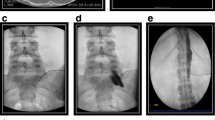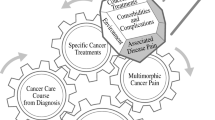Abstract
Purpose of Review
Despite the rapid advance in anti-cancer treatment in recent years, the treatment to cancer-related pain remains largely unchanged. One systemic review has shown that approximately 32% of patient with cancer-related pain were undertreated. While in patients responding to strong opioids, long-term use of opioids will lead to many undesired side effects such as constipation, tolerance, and addiction. The goals of this review are to re visit the current algorism of cancer pain management and bring attention to the emerging interventional pain management techniques.
Recent Findings
Peripheral nerve stimulation (PNS) has been successfully used to treat certain types of chronic non-cancer pain with long-term analgesic effect. PNS has also brought some promising results in treating localized cancer-related pain in a pilot study.
Summary
More studies are needed to advance the novel and safe treatment of cancer-related pain. Incorporating interventional techniques such as PNS properly can optimize the current treatment strategy and improve outcomes.
Similar content being viewed by others
References
Papers of particular interest, published recently, have been highlighted as: • Of importance •• Of major importance
van den Beuken-van Everdingen MH, de Rijke JM, Kessels AG, Schouten HC, van Kleef M, Patijn J. Prevalence of pain in patients with cancer: a systematic review of the past 40 years. Ann Oncol. 2007;18(9):1437–49.
Anekar AA, Cascella M. WHO Analgesic Ladder. 2021 May 18. In: StatPearls [Internet]. Treasure Island (FL): StatPearls Publishing; 2022. This paper discussed the revised WHO analgesic ladder and brought the "fourth step: interventional and minimally invasive procedures" into attention.
Swarm RA, Paice JA, Anghelescu DL, Are M, Bruce JY, Buga S, et al. Adult Cancer Pain, Version 3.2019, NCCN Clinical Practice Guidelines in Oncology. J Natl Compr Canc Netw. 2019;17(8):977-1007. This is the newest guldeline for cancer-related pain management from NCCN with comprehensive review of current status of each treatment option.
Azevedo Sao Leao Ferreira K, Kimura M, Jacobsen Teixeira M. The WHO analgesic ladder for cancer pain control, twenty years of use. How much pain relief does one get from using it? Support Care Cancer. 2006;14(11):1086–93.
Breivik H, Cherny N, Collett B, de Conno F, Filbet M, Foubert AJ, et al. Cancer-related pain: a pan-European survey of prevalence, treatment, and patient attitudes. Ann Oncol. 2009;20(8):1420–33.
Greco MT, Roberto A, Corli O, Deandrea S, Bandieri E, Cavuto S, et al. Quality of cancer pain management: an update of a systematic review of undertreatment of patients with cancer. J Clin Oncol. 2014;32(36):4149–54.
Fallon M, Giusti R, Aielli F, Hoskin P, Rolke R, Sharma M, et al. Management of cancer pain in adult patients: ESMO Clinical Practice Guidelines. Ann Oncol. 2018;29 Suppl 4:iv166-iv91. This is the new guideline for cancer pain management from ESMO.
Straube C, Derry S, Jackson KC, Wiffen PJ, Bell RF, Strassels S, et al. Codeine, alone and with paracetamol (acetaminophen), for cancer pain. Cochrane Database Syst Rev. 2014;9:CD006601.
Wiffen PJ, Derry S, Moore RA. Tramadol with or without paracetamol (acetaminophen) for cancer pain. Cochrane Database Syst Rev. 2017;5:CD012508.
Wiffen PJ, Wee B, Derry S, Bell RF, Moore RA. Opioids for cancer pain - an overview of Cochrane reviews. Cochrane Database Syst Rev. 2017;7:CD012592.
Candido KD, Kusper TM, Knezevic NN. New Cancer Pain Treatment Options. Curr Pain Headache Rep. 2017;21(2):12.
Klepstad P, Kurita GP, Mercadante S, Sjogren P. Evidence of peripheral nerve blocks for cancer-related pain: a systematic review. Minerva Anestesiol. 2015;81(7):789–93.
Wall PD, Sweet WH. Temporary abolition of pain in man. Science. 1967;155(3758):108–9.
Weiner RL, Reed KL. Peripheral neurostimulation for control of intractable occipital neuralgia. Neuromodulation. 1999;2(3):217–21.
Petersen EA, Slavin KV. Peripheral nerve/field stimulation for chronic pain. Neurosurg Clin N Am. 2014;25(4):789–97.
Xu J, Sun Z, Wu J, Rana M, Garza J, Zhu AC, et al. Peripheral Nerve Stimulation in Pain Management: A Systematic Review. Pain Physician. 2021;24(2):E131-E52. The most up-to-date review of PNS in chronic pain management.
Deer TR, Esposito MF, McRoberts WP, Grider JS, Sayed D, Verrills P, et al. A Systematic Literature Review of Peripheral Nerve Stimulation Therapies for the Treatment of Pain. Pain Med. 2020;21(8):1590–603.
Mainkar O, Solla CA, Chen G, Legler A, Gulati A. Pilot Study in Temporary Peripheral Nerve Stimulation in Oncologic Pain. Neuromodulation. 2020;23(6):819-26. The first paper to decribe the use of PNS to treat chronic cancer-related pain with long term outcome.
Cohen SP, Gilmore CA, Rauck RL, Lester DD, Trainer RJ, Phan T, et al. Percutaneous Peripheral Nerve Stimulation for the Treatment of Chronic Pain Following Amputation. Mil Med. 2019;184(7–8):e267–74.
Gilmore CA, Ilfeld BM, Rosenow JM, Li S, Desai MJ, Hunter CW, et al. Percutaneous 60-day peripheral nerve stimulation implant provides sustained relief of chronic pain following amputation: 12-month follow-up of a randomized, double-blind, placebo-controlled trial. Reg Anesth Pain Med. 2019;rapm-2019-100937. https://doi.org/10.1136/rapm-2019-100937.
Langford B, Mauck WD. Peripheral Nerve Stimulation: A New Treatment for Meralgia Paresthetica. Pain Med. 2021;22(1):213–6.
Dey S. Comparing neuromodulation modalities involving the suprascapular nerve in chronic refractory shoulder pain: retrospective case series and literature review. Clin Shoulder Elb. 2021;24(1):36–41.
Mazzola A, Spinner D. Ultrasound-Guided Peripheral Nerve Stimulation for Shoulder Pain: Anatomic Review and Assessment of the Current Clinical Evidence. Pain Physician. 2020;23(5):E461–74.
Gilmore CA, Kapural L, McGee MJ, Boggs JW. Percutaneous Peripheral Nerve Stimulation (PNS) for the Treatment of Chronic Low Back Pain Provides Sustained Relief. Neuromodulation. 2019;22(5):615–20.
Melzack R, Wall PD. Pain mechanisms: a new theory. Science. 1965;150(3699):971–9.
Basbaum AI, Bautista DM, Scherrer G, Julius D. Cellular and molecular mechanisms of pain. Cell. 2009;139(2):267–84.
Deer TR, Jain S, Hunter C, Chakravarthy K. Neurostimulation for Intractable Chronic Pain. Brain Sci. 2019;9(2):23. https://doi.org/10.3390/brainsci9020023.
Deer TR, Eldabe S, Falowski SM, Huntoon MA, Staats PS, Cassar IR, et al. Peripherally Induced Reconditioning of the Central Nervous System: A Proposed Mechanistic Theory for Sustained Relief of Chronic Pain with Percutaneous Peripheral Nerve Stimulation. J Pain Res. 2021;14:721-36. This paper describes some propposed mechanisms of PNS based on the current understanding of the treatment.
Ilfeld BM, Gabriel RA, Saulino MF, Chae J, Peckham PH, Grant SA, et al. Infection Rates of Electrical Leads Used for Percutaneous Neurostimulation of the Peripheral Nervous System. Pain Pract. 2017;17(6):753–62.
Author information
Authors and Affiliations
Corresponding author
Additional information
Publisher's Note
Springer Nature remains neutral with regard to jurisdictional claims in published maps and institutional affiliations.
This article is part of the Topical Collection on Anesthesiology and Critical Care
Rights and permissions
About this article
Cite this article
Zhang, H. Cancer Pain Management—New Therapies. Curr Oncol Rep 24, 223–226 (2022). https://doi.org/10.1007/s11912-021-01166-z
Accepted:
Published:
Issue Date:
DOI: https://doi.org/10.1007/s11912-021-01166-z




